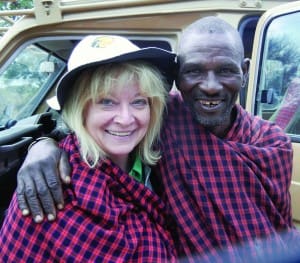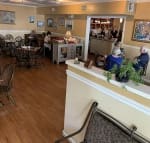ONCE IN A LIFETIME – TANZANIA AND THE SERENGETI
Our Once in a Lifetime Adventure!
Tanzania and the Serengeti
Article by Pam Euston Photos by Pam and Donald E. Euston
This article and photographs were submitted to Lighthouse Point Magazine by Donald and Pamela Euston, who have lived in Pompano Beach on Harbor Village Island since 1982, and residents of South Florida since 1975. Don is a financial analyst with Merrill Lynch, and a member of the Lighthouse Point Saltwater Sportsman’s Association. Pam is a member of the Pompano Soroptimists. The couple has traveled all over the world and their adventures are always exciting and one-of-a-kind experiences. They decided to share this latest journey with us. Hope you enjoy it.
TANZANIA
Friday, June 1

After much anticipation, we began our journey to Tanzania and the Serengeti. On Saturday evening, June 2, we landed at Kilimanjaro International Airport, some three flights and 35 hours later. We felt as though we had landed in the Land of the Munchkins; our huge KLM Airbus was bigger than the terminal! We were met by our guide, Ridas Michael Lazier, a member of the Maasai tribe, and drove for over an hour into Arusha and the Olasiti Lodge. This is our fifth trip with Overseas Adventure Travel based in Cambridge, Massachusetts. They limit their trips to 16 people maximum and really get you off the beaten path. We have been on OAT trips to Peru and the Galapagos Islands, Vietnam, Cambodia, Myanmar, Thailand, Nepal and Tibet. We feel that they offer an exceptional travel value and our travels have enabled us to see villages in these countries and meet people that we would not have been able to on our own.
When I was in grade school, Tanzania was known as Tanganyika. Today, the United Republic of Tanzania consists of the mainland republic and the island republic of Zanzibar. Dar es Salaam, located on the Indian Ocean, is the country’s largest city and Dodoma, the capital, both lie in the middle of the country. Tanzania is one of Africa’s poorest countries and the main industries are tourism, agriculture and mining, primarily for tanzanite. In 1961, Tanganyika became the first African nation to gain independence; Zanzibar followed in 1964.
Sunday, June 3
There were nine in our group, and on this morning we boarded our Land Cruisers and started the three-hour drive to the foothills of Mount Kilimanjaro, Africa’s highest peak at 19,344 feet. We are joined by Nixon Sarumba, who drove the second car and we started on our way.
Arusha, like most of Tanzania, is an assault on the senses—so much activity, colors and sounds as we passed local markets with shopkeepers setting out their wares. “Hatari,” the 1960s movie starring John Wayne, was filled in and around Arusha. On our way out of town, we passed a marker; we are exactly half-way between Cairo to the north and Johannesburg to the south. It wasn’t long before we were out of the congestion of the city and into the countryside, passing many acres of sunflowers, which are grown for their oil. We were still on a paved highway, but that would soon change as we made our way further and further away from civilization as we knew it. The paved highway gave way to a gravel road, to a dirt road, to a path that was hard to find, and finally to no road at all, followed by ‘blaze your own trail!’ By mid-afternoon we reached Sinya Camp and got settled in, and then met the camp staff and our two resident Maasai guards, Tinay and Masanga. Tent, Sweet Tent. This was our home during our visit to the foothills of Kilimanjaro.
Every morning the top would be taken off our Land Cruisers and we would set out in search of animals to photograph. The Maasai are one of Tanzania’s most colorful tribes. They are pastoral nomads who have actively resisted change, and still follow the same lifestyle that they have for centuries. Their culture centers on their cattle, which provide many of their needs—milk, blood and beef for their diet, and hides and skins for their clothing. Sheep and goats also play an important dietary role, especially during the dry season, which was just now beginning. The land, cattle, and all things related to cattle are considered sacred. Their society is patriarchal and highly decentralized. Elders meet to decide on general issues, but ultimately it is the well-being of the cattle that determines a course of action.
Maasai woman play a markedly subservient role and have no inheritance rights. Polygamy is widespread and it is not unusual for a Massai warrior to have several wives. Tinay has two and is in the process of “interviewing” the parents of wife number three. He has many children. Masanga has one wife and one child. It is considered very ill-mannered to ask a Massai warrior how many wives and children he has. Rather you ask, “How are the cows, and how are the children?”
Later in the afternoon, after getting settled in to our very comfy tents, the two took us on a nature walk. Little did we know that there was a veritable pharmacy growing all around us. We hiked up to a ridge where we saw our first wildlife—giraffes and zebras down below us in a valley. Some of the staff had brought a table and a cooler of wine and beer up to the ridge. It doesn’t get any better than toasting Mount Kilimanjaro at dusk and Mount Meru off in the distance with nothing but the sound of the wind. Before heading for our tents, we are reminded once again not to go out of our tent during the night. Tinay and Masanga patrolled the camp during the night as well as some of the staff who were armed. No one had trouble sleeping that night, although it was a little scary falling asleep to hyenas whooping, zebras snorting, and an occasional lion roar.
Monday, June 4
We were up early, and the tops came off the Land Cruisers as we are heading out game watching. Mount Kilimanjaro’s summit was still covered with clouds, as it usually was this time of year…the Massai call the mountain the “shy lady” for that reason. No one could seem to agree exactly what Kilimanjaro means. Most linguists say that it is Swahili for “bright and shining hill.”
It wasn’t long before we encountered a tower of giraffes, who were too busy munching on acacia leaves to notice us. In amongst them were zebras and wildebeest. These three often hang out together as a protection against predators. The wildebeest has a very keen sense of smell but poor eyesight. The zebra has great eye sight, but not as good a sense of smell. The giraffe, with its height, can see trouble coming a long way off. When one of the group got “spooked,” they all took off.
On we drove, and soon ran into Thomson and Grant’s gazelles, both very pretty members of the antelope family. Especially, the little Thomsons. Their little black and white tails never stop twitching and both have a beautiful face. Ridas told us that when the wildebeest and zebras are running together, the pregnant females will all “drop” their babies at one time. Any predators following them will eat the placenta, and the herd will continue on their way.
Next up, were a troop of baboons, hurrying along with their tails up in the air. I guess this is where the expression “let’s high tail it out of here” came from. Some females had a baby holding on to their chest. Carrying a baby baboon this way serves two important purposes: the baby can nurse, and hold on tight in case mom has to make a fast getaway.
Late in the afternoon, we visited Tinay’s boma, our village. The Maasai build a round house out of mud; the roof is thatched and there are no windows in the structure. Each wife has her own boma where she and her children live. A fire is always burning inside. The village is circular and surrounded by a “fence” of acacia branches that have very sharp needles or thorns. The cattle are brought into the center of the village and are kept together by another fence of acacia branches. In the morning, they are led out to graze, usually by very young Massai boys. There are no couch potatoes within the Massai tribe.
Tuesday, June 5
After spending three nights at Sinya Camp, we packed up and headed back to Arusha, dropping Tinay off at his cousin’s village, so he can check out prospective wife number three. He would walk the ten miles back to his village. There was no overweight Maasai, as they walked everywhere. Finally, we can see the snows of Kilimanjaro, as the clouds parted and the summit of the mountain was so beautiful in the morning sunlight.
On our way back to the city, we drove through “Giraffsic Park” and saw more of these animals than ever before. Males can grow to a height of 18 feet and they can run up to 35 mph. Most predators leave them alone; a kick from a giraffe can kill a lion. We also encountered ostriches and more gazelles. When giraffes are born, they fall six feet to the ground, and within minutes are up and walking.
Wednesday, June 6
We completed our pre-trip to Mount Kilimanjaro, and today began the main part of the trip. Now, there were 13 of us and we were joined by an additional guide, Joshua Loy Lovuto. Leaving the hotel in the morning, we set out for the Burka Coffee Estates, a 2000 acre coffee plantation. Their main customer is Starbucks, and once we learned how coffee is harvested, it was easy to see why it costs what it does. From September to April, the bushes are picked every two weeks as the berries ripen. It must be done by hand and is a very labor intensive process.
Next ,we visited the Shanga River House, a cooperative for physically handicapped Tanzanians that was started four years ago by the wife of the owner of Burka Coffee Estates. Today, they employ 55 people who make various Tanzanian crafts from recycled materials. We had lunch here in a beautiful setting. This was a highlight of our trip, and the motto of Shanga River House is “Kindess is a language that blind people see and deaf people hear.”
Thursday, June 7
Everyone was up early, for on this today we left Arusha and headed for the Tarangire National Park, Tanzania’s third largest park. We left the Olasiti Lodge early and were soon on our way. We packed box lunches and upon arriving at the entrance of the park, enjoyed a picnic lunch.
Tarangire stretches southeast of Lake Manyara, around the Tarangire River and is studded with beautiful baobab trees. It is part of an extended ecosystem where animals roam freely. Off came the roofs of the Land Cruisers, and out into the park we went. What a day! It wasn’t long before we were in the middle of a herd of elephants. They just walked around our vehicles. Next came Cape Buffalo, more giraffes and gazelles and a variety of beautiful birds including the Splendid Starling. It was the elephants that became our favorites. They can live seventy years or more, and are loving parents; if they feel a threat they will form a circle facing outwards with the babies in the middle of the circle. They have greeting ceremonies when a member of the group has been away for some time and returns. hey grieve at the loss of a stillborn baby and are reluctant to leave a dead member of their group. Ridas said that he had seen this. Once a group came upon a dead elephant that was not a member of their herd, and they tried to coax him to his feet and seemed reluctant to leave him. They are sensitive animals, and when a baby complains, the entire family will unite and rumble over to caress and touch it. We sat for what seemed hours just watching them, especially when we encountered a baby being taught by mom how to strip the bark off a baobab tree.
We ended our day at the Lake Burunge Tented Camp that is permanent. Our tents were very luxurious and were on an elevated platform some eight feet off the ground. Once again, we were reminded not to come out of the tent during the night, as if we needed to be told. Once again, we awoke before the sun came up to the sounds of something snorting around below us. We spent a second day, June 8, in the Tarangire National Park.
Saturday, June 9
Up early again, and off to spend the day with the Maasai in a boma (village). This was another highlight of our trip. We met the chief, who has four wives and 27 children. We also met his eldest son, who is now forty and has two wives. When he was fourteen years old, he killed a lion that was attacking the cattle herd. He was seriously injured and before being transported to the closest hospital, was treated by placing a piece of raw lamb meat on the wound. This acted as a sort of graph which amazed the hospital doctors. He was in the hospital for two months. The ladies of the boma provided us with shukas (their traditional dress which is a piece of cloth that they tie around them), and jewelry. We learned how to patch the roof and other household chores and were also taught to dance. It was a wonderful and a very educational experience. Don and the chief’s eldest son, who we called “the Lion King,” due to the fact that he killed a lion that was attacking his cattle when he was fourteen years old, and will become chief upon his father’s death.
After that we continued on our way to the Ngorongoro Highlands and finally arrived at the Tloma Lodge near the town of Karatu. We were now at 4000 feet and very cool; reminded me of Dalat, when we were in Vietnam.
LOOK FOR THE SERENGETI IN OUR OCTOBER ISSUE!







